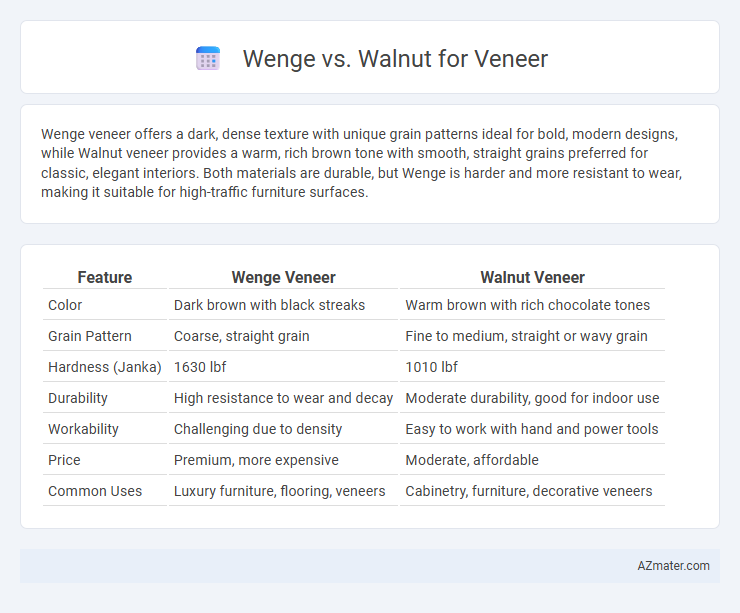Wenge veneer offers a dark, dense texture with unique grain patterns ideal for bold, modern designs, while Walnut veneer provides a warm, rich brown tone with smooth, straight grains preferred for classic, elegant interiors. Both materials are durable, but Wenge is harder and more resistant to wear, making it suitable for high-traffic furniture surfaces.
Table of Comparison
| Feature | Wenge Veneer | Walnut Veneer |
|---|---|---|
| Color | Dark brown with black streaks | Warm brown with rich chocolate tones |
| Grain Pattern | Coarse, straight grain | Fine to medium, straight or wavy grain |
| Hardness (Janka) | 1630 lbf | 1010 lbf |
| Durability | High resistance to wear and decay | Moderate durability, good for indoor use |
| Workability | Challenging due to density | Easy to work with hand and power tools |
| Price | Premium, more expensive | Moderate, affordable |
| Common Uses | Luxury furniture, flooring, veneers | Cabinetry, furniture, decorative veneers |
Introduction to Wenge and Walnut Veneers
Wenge veneer, known for its deep, dark brown color with distinctive black streaks, offers a bold and exotic appearance ideal for high-end furniture and cabinetry. Walnut veneer features a warm, rich brown tone with subtle grain patterns that provide a classic and versatile look suitable for both traditional and modern designs. Both veneers are prized for their durability and fine texture, making them excellent choices for enhancing interior aesthetics with natural wood elegance.
Origin and Botanical Background
Wenge veneer is sourced primarily from the Millettia laurentii tree native to Central Africa, known for its dense and durable hardwood with a distinctive dark brown to black color and fine, straight grain. Walnut veneer comes from the Juglans genus, predominantly Juglans nigra (black walnut) found in North America, prized for its rich, warm brown hues and intricate, wavy grain patterns. Both species belong to the Fabaceae and Juglandaceae families respectively, reflecting their unique botanical characteristics that influence veneer texture, color, and workability.
Color and Grain Patterns Comparison
Wenge veneer is known for its deep, dark brown color with subtle black streaks, creating a rich, dramatic appearance, while walnut veneer typically features a warm, medium brown tone with hints of purple or gray. The grain pattern of wenge is straight with a slightly coarse texture, offering a bold and striking linear look, whereas walnut exhibits a more varied, swirling grain with occasional knots, providing a softer, more natural feel. Both veneers are prized for their unique aesthetics, but wenge's intense contrast suits modern interiors, while walnut's classic, elegant grain is favored in traditional and transitional designs.
Durability and Strength Differences
Wenge veneer exhibits higher durability and resistance to wear compared to walnut, making it ideal for heavy-use applications. Walnut veneer, while slightly softer, offers sufficient strength with superior flexibility and aesthetic versatility in furniture design. Both woods provide excellent quality, but Wenge's hardness rating of 4 on the Janka scale surpasses Walnut's 1.0, ensuring longer-lasting performance in high-traffic environments.
Workability and Application
Wenge veneer offers high durability and a distinctive dark grain that enhances its appeal in luxury furniture, yet its coarse texture requires precise cutting tools for clean edges, making it less forgiving during installation. Walnut veneer provides excellent workability due to its fine, even grain, allowing easy sanding and finishing, which suits it well for intricate cabinetry and decorative panels. Both veneers are favored in high-end interior applications, with walnut preferred for smooth, detailed work and wenge chosen for bold, contemporary designs requiring robust material performance.
Cost and Availability
Wenge veneer typically commands a higher price than walnut due to its exotic nature and limited availability, making it a premium choice for luxury furniture. Walnut veneer enjoys broader availability and more competitive pricing, supported by sustainable harvesting practices and widespread cultivation. Both veneers offer durability and deep wood grain patterns, but cost and ease of sourcing should guide selection based on project budget and timeline.
Sustainability and Environmental Impact
Wenge veneer, sourced primarily from Central African rainforests, faces sustainability challenges due to overharvesting and slow growth rates, increasing the risk of deforestation and habitat loss. Walnut veneer, often harvested from temperate forests in North America and Europe, generally benefits from more regulated forestry practices and faster tree regeneration, resulting in a comparatively lower environmental impact. Selecting certified sustainable sources like FSC-certified walnut can significantly reduce ecological footprints compared to non-certified wenge veneer.
Ideal Uses for Wenge Veneer
Wenge veneer excels in high-end furniture and cabinetry due to its deep, rich brown tones and distinctive dark streaks, providing a luxurious and dramatic aesthetic. Its dense, durable hardwood properties make it ideal for surfaces requiring both strength and visual impact, such as conference tables and architectural paneling. Compared to walnut, wenge's bolder grain and color variations suit modern and contemporary designs that demand a striking contrast and unique texture.
Ideal Uses for Walnut Veneer
Walnut veneer is ideal for creating elegant and sophisticated furniture, cabinetry, and paneling due to its rich, warm brown tones and fine straight grain that enhances luxurious interiors. Its durability and smooth finish make it perfect for high-end residential and office environments where aesthetics and longevity are crucial. Compared to wenge, walnut veneer offers greater versatility in modern and classic design schemes, complementing a wide range of decor styles.
Choosing Between Wenge and Walnut for Your Project
Wenge veneer offers a dark, rich brown color with striking black streaks, providing a bold and exotic look that stands out in modern and contemporary designs. Walnut veneer features a warm, medium-brown tone with a fine, straight grain pattern, delivering a versatile and classic appearance suitable for traditional and transitional projects. Choosing between Wenge and Walnut depends on the desired aesthetic impact and furniture style, with Wenge best for dramatic contrast and Walnut favored for timeless elegance.

Infographic: Wenge vs Walnut for Veneer
 azmater.com
azmater.com